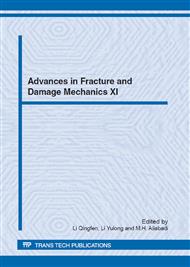p.81
p.85
p.89
p.93
p.97
p.101
p.105
p.109
p.113
Simulation of Spall Fracture Based on Material Point Method
Abstract:
The spall fracture is a shock wave induced dynamic fracture phenomenon, it’s difficult to capture the features of the spall fracture when traditional finite element method based on continuum mechanics is applied. In this paper, a new and flexible meshless method, material point method, is used to study the spall fracture of metal material in the case of hypervelocity impact. Firstly, a computational process is given in which Johnson-cook plasticity model, Mie-Grüneisen equation of state and several failure models including hydrodynamic tensile failure model, effective plastic strain model and Johnson-cook failure model are considered. Then a 3D simulation of spall fracture of an armco iron target under impact loads by a 2024-T351aluminum projectile is carried out. At last, the numerical results show that the material point method can accurately capture important features of spall fracture such as the arrival times, magnitudes and shapes of both the compressive waves and tensile reflections in the spall region, and it’s proven that material point method is suitable to simulate the spall fracture in engineering applications.
Info:
Periodical:
Pages:
97-100
Citation:
Online since:
November 2012
Authors:
Price:
Сopyright:
© 2013 Trans Tech Publications Ltd. All Rights Reserved
Share:
Citation:


